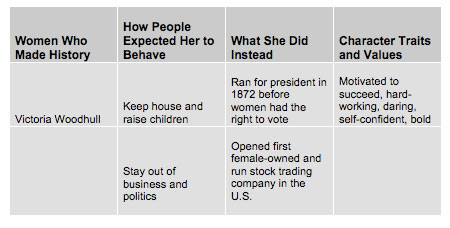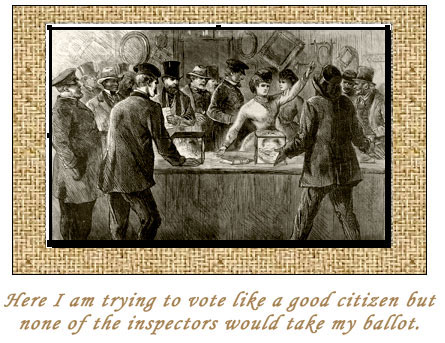Well-behaved Women [and Men] Seldom Make History
 ,
, 
Picture book biographies can provide young readers with a great deal of information. Yet without a focus for reading, students often pay attention to interesting details and tidbits—what's been called the "terrific specifics"—rather than the big ideas in history. This guide focuses students' attention on two main ideas that promote historical thinking:
Understanding historical context Understanding individual efforts that promoted social change
As they read and respond to picture book biographies, students will see fundamental differences between the past and the present and witness the impact some people had on the times in which they lived. Though they were sometimes criticized for inappropriate or outrageous behavior, to quote historian Laurel Thatcher Ulrich's famous slogan, "Well-behaved women seldom make history." To this I would only add, or men. (While this guide is primarily concerned with the values and character traits of women who made history, it could easily be extended to include men as well.)
First students read and discuss picture book biographies of women in history. With their teacher, they build a data chart of information about each woman, highlighting her historical setting, accomplishments, and character traits. Finally students apply what they learn to several writing projects focused on historical context and social change. While the focus of biography is on individuals, students will see they did not, and could not, succeed alone but were supported along the way by others.
- From the list of recommended biographies, pick the books you want to use (four to six is a good number to start with).
- If you only have one copy, read the biography out loud to students. If each student has his or her own copy, students can read independently after a short introduction.
- Review the blank data chart found in the Handouts for Students and each writing assignment. Make copies as needed.
- You can display a large (class) copy of the chart, while students have smaller copies.
[All examples are from A Woman for President: The Story of Victoria Woodhull (2004) by Kathleen Krull, illustrated by Jane Dyer]
- Introduce the data chart. Explain that the class will be reading books about women who made history and filling a chart with information about the women. Have students consider:
-
- When did the woman live? How do you know?
- How was she expected to behave?
- What did she do instead?
- What does this show about her character and values?
-
- Introduce each book with information about the woman and the challenges she faced. Show a few of the pictures to add a sense of historical context. Introduce vocabulary words essential to understanding the book.
- Read the book aloud.
- After reading, complete a row in the chart. When the chart is completed and you have read all the books you selected, discuss:
-
- Which experiences were similar?
- How did expectations for women's behavior differ from the way they are today? How were they similar?
- What character traits and values did the women share?
- Is it true "well-behaved women seldom make history?"
-
- Based on A Woman for President, here's an example of a row from the data chart:

In the Classroom: Writing Projects—Historical ContextThe two projects below focus students' attention on envisioning the historical setting. Student handouts are provided for each project.
One: Photograph Album with Captions
Ask students to create an imaginary photo album for one of the women. Using "Photo Album from the Past," have students draw interesting and important moments from the woman's life. Visual material downloaded from the internet can be included to make these photos more realistic. Under each picture, students can supply captions for the photo pointing out interesting details. Here is an example of a "photo" and caption from the album of Victoria Woodhull:

Two: Imaginary Interviews
With a partner, have students prepare for an interview with one of the women. First, students brainstorm what questions to ask, then write their questions down and provide an answer the woman would give. Have the students practice giving the interview before presenting to the class. Completed written interviews can be illustrated and collected for display or made into a class book. Sample interview questions could include:
-
- In your day, what did people expect you to do?
- What was your biggest accomplishment? Why does it make you proud?
- How would you describe yourself?
- What qualities do you respect in other people?
Ask students to add additional questions. See an example of an interview with Victoria Woodhull in the Examples Packet.
In the Classroom: Writing Projects—Character Traits and ValuesThe two projects below focus attention on the character traits and values of the women studied. Student handouts are provided for each project.
One: Character Sociogram
This is a way to show how a person thinks and behaves and how people respond to them. An example from the packet shows Victoria Woodhull's interactions with several contemporaries. The words on the arrows show the feelings and actions of one person toward another. Though only four people are shown (besides the woman in the center), more people may be added. Using one of the shared biographies, model how to make a sociogram with the whole class. Have student partners complete a sociogram for one of the women studied. After students complete several sociograms, discuss the common traits and values of women who made history. See an example of a sociogram based on the life of Victoria Woodhull in the Examples Packet.
Two: Concept Circles
This strategy teaches students to see the connections between words. Using words that explore character traits and values, this vocabulary exercise gives students the opportunity to describe the women using new, or recently learned, words. From the handout provided, place a word or phrase describing character traits and values for one of the women studied in each section of the circle. Skim the biography for these words and phrases. Have student partners discuss how each word or phrase helped them understand that person. After the discussion, have students write descriptions of the woman, describing the obstacles she faced and how she overcame them. Ask students to use vocabulary from the concept circle in their descriptions. See an example of a concept circle about Victoria Woodhull in the Examples Packet.
Common Pitfalls- Even though the recommended books are picture books, it may take more than one class period to read aloud. Don't rush through the book. Provide enough time for background information and student comments on the book.
- Students often want to report on everything they have learned after listening to a read-aloud. Praise your students for learning new information, but then focus them on the chosen topics (historical context and efforts to promote social change).
- For written assignments, make sure students use information from books rather than made-up information. Have books available so students can refer to them.
-
